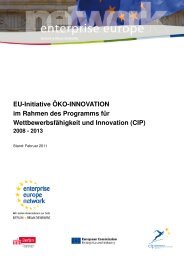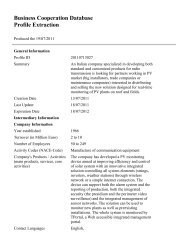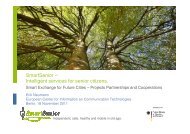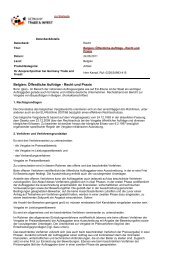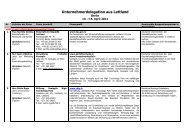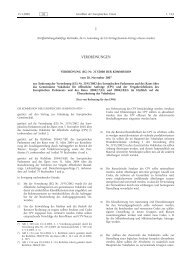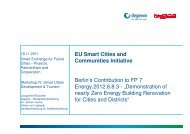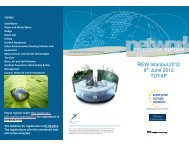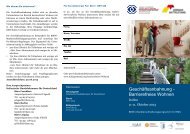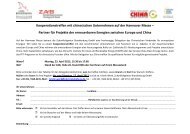Photonics Driving Economic Growth in Europe - Photonics21
Photonics Driving Economic Growth in Europe - Photonics21
Photonics Driving Economic Growth in Europe - Photonics21
You also want an ePaper? Increase the reach of your titles
YUMPU automatically turns print PDFs into web optimized ePapers that Google loves.
92 Towards 2020 – <strong>Photonics</strong> driv<strong>in</strong>g economic growth <strong>in</strong> <strong>Europe</strong><br />
B-PHOT’s photonics science show<br />
for students and teachers where<br />
two researchers make a student<br />
disappear. © VUB<br />
n FET Flagships: <strong>Photonics</strong> is already key <strong>in</strong><br />
some of the FET Flagships projects, hence it is<br />
recommended that this activity could be used<br />
to enhance communication and dissem<strong>in</strong>ation<br />
of FET Flagships through attractive ways of<br />
communication, audio-visual, etc.. A good<br />
visibility of successful photonics projects will<br />
foster further actions <strong>in</strong> the field.<br />
2. ERC grants<br />
ERC grants are traditionally devoted to fund<strong>in</strong>g<br />
projects of scientific excellence. Although quantum<br />
electronics and optics related research have been<br />
funded <strong>in</strong> the past, the scientific excellence under-<br />
ly<strong>in</strong>g photonics technologies seems to have been<br />
underestimated. Although specific topics cannot<br />
be <strong>in</strong>troduced <strong>in</strong> the fully bottom up ERC research<br />
programme, it is recommended that the <strong>Europe</strong>an<br />
Commission:<br />
n raises the number of photonics<br />
professionals <strong>in</strong> the evaluation<br />
committees of the Physical Sciences<br />
and Eng<strong>in</strong>eer<strong>in</strong>g Panel<br />
n communicates and dissem<strong>in</strong>ates<br />
photonics related ERC Grantees and<br />
their projects as success stories<br />
n enhances l<strong>in</strong>ks between the ERC<br />
Scientific Committee and ERC<br />
Executive Agency and photonics<br />
stakeholders <strong>in</strong> <strong>Europe</strong><br />
3. Access to Research Infrastructure<br />
This aspect is fundamental for research <strong>in</strong>stitutions<br />
and universities to promote mobility of researchers<br />
and to ensure efficient usage of facilities. Although<br />
ESFRI <strong>in</strong>frastructures will have a priority under this activity,<br />
it is recommended that the Commission facilitates<br />
this support through other forms of alliances<br />
or networks of research facilities & <strong>in</strong>frastructures,<br />
both specific to photonics and to KETs <strong>in</strong> general.<br />
Education and Tra<strong>in</strong><strong>in</strong>g<br />
Past experience has demonstrated that imple-<br />
mentation of successful and effective actions to<br />
promote photonics <strong>in</strong> education and tra<strong>in</strong><strong>in</strong>g has<br />
been difficult and challeng<strong>in</strong>g. In addition to the<br />
above recommendations reported, the follow<strong>in</strong>g<br />
aspects should be considered:<br />
1. Outreach<br />
n Exhibitions and shows: Exhibitions and shows,<br />
fairs and festivals each provide an effective<br />
opportunity for the wider popularisation of pho-<br />
tonics to the society, and need to be enhanced<br />
and provided at a <strong>Europe</strong>an level. Strategic<br />
alliances with committed members allow for<br />
the design and implementation of activities,<br />
foster<strong>in</strong>g a wide participation from other stake-<br />
holders. Connections should be established with<br />
exist<strong>in</strong>g networks and programs (for example,<br />
ECSITE, PLACES, NetS-EU). The <strong>in</strong>volvement of<br />
the Commission will be essential for the identification,<br />
enabl<strong>in</strong>g and evaluation of the actions.<br />
n ‘Liv<strong>in</strong>g Lab’ and ‘Fab Lab’: Two new concepts<br />
are ‘Liv<strong>in</strong>g Labs’, allow<strong>in</strong>g some experiments to<br />
be performed by visitors under suitable supervision,<br />
and ‘Fab Labs’, allow<strong>in</strong>g tools to be<br />
assembled and used by visitors to build some<br />
simple prototypes. These should be exploited by<br />
Science and Technology museums (and possibly



